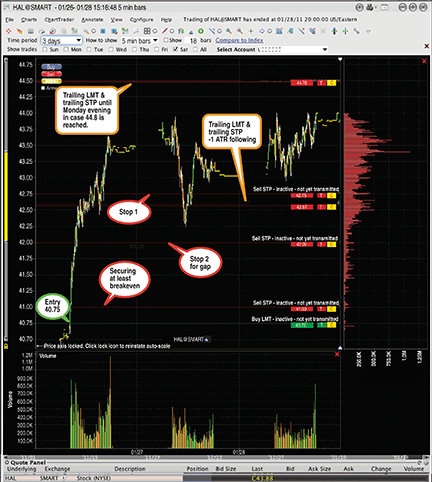REAL WORLD
My Trade Watchdog
Advanced Oca Orders
Here are some simple ideas and concepts to automate stops, using “one cancels all” orders.
Every trade demands a stop-loss order. I cannot enter a position without a stop because the size of every trade is limited by the distance from entry to stop. Since my trading horizon is anywhere from several days to several weeks, I move stops in the direction of the trade once the price moves in my favor.
Modern platforms provide the ability to use trailing stops, moving stops in the direction of your trade. When the price moves against you, that triggers a stop and you are out with only a small loss or even with a profit. This method is often used for profit-taking, especially when you expect the market to move quickly in your direction.
No matter how you decide to move your stops, there are some additional concepts to help protect your trades. Think of a watchdog that guards your positions while you are not in front of your computer. Even if you sit in front of the screen, you cannot monitor too many tickers at once. For me, as a trader in Europe watching the US market, it is even more difficult, due to the time difference. I don’t want to spend all my evenings in front of one screen, let alone multiple screens.
As a result, I use “one cancels all” (Oca) orders to secure my positions and create flexible exit scenarios. A standard Oca order consists of two legs — one to take profits at a predetermined target and the other to limit a loss. Once either of the orders is triggered, the other one is canceled.
I use Oca orders to set a larger group of orders that are connected and only one of them will be filled; I want to use limit orders whenever possible. Think of using a trailing stop order. This means that when the stop price is triggered, a market order is issued. Such an order will most likely add another small loss due to slippage. Using a trailing limit order can solve this problem. The trouble is that a trailing limit order might not get filled if prices jump across it in a fast market.

Figure 1: creating advanced exit strategies. Here you see where you should place your stops, trailing limits, and trailing stops if you enter your position at 40.75.